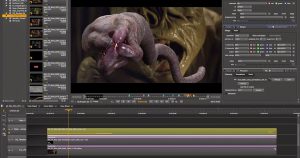Software Introduction
Foundry Nuke Studio can be used in the film industry. Foundry Nuke is a professional tool for the film industry. It allows you to correct, color correct, and add visual effects. Nuke’s new Hydra enabled 3D viewer utilizes hdStorm to render the viewport. This allows for a 3D experience that is similar to the output of Scanline Render, and also provides consistency between other applications using Hydra. The Hydra viewer has been made available for Linux and Windows in Nuke 13.0.

Foundry Nuke Studio Features
Nodal toolkit
Nuke has everything you need for digital compositing. Nuke includes keyboards that are industry standard, spinning glasses, and vector paint tools. It also offers color correction.
Deep Image Merge
The deep image compositing tool allows you to create and work on images with a high level of opacity and color per pixel. This means that there is no need to re-render CG elements when the content changes.
Rotoscoping
The Nuke’s integrated Roto button, which is accessible through an intuitive layering system that folds down to reveal all the tools, allows for precise control over even the most complicated rotating glasswork.
Tracker 2D
Nuke’s keyframe tracking allows you to track and correct difficult objects with ease and accuracy. It solves difficult occlusion issues and brightness variations in a quick and painless manner.
Keying
Nuke offers a number of keyers that can be used to extract mattes from an image. These include industry-standard keyers like Primatte, Ultimatte, and IBK from Nuke as well as Keylight (r) from Foundry.
Keylight
Keylight(r), a blue and green screen keyboard, is a tried and tested product that excels in handling reflections and semi-transparent regions. It also handles hair and semi-transparent areas.
Reliability
Nuke’s Relight feature allows you to preview and edit changes in 3D without needing to switch to other software packages.
Warp Effect
Nuke’s Warp Effects let you transform images within parameters that you define, whether you are working with a vector, a contour, or a mesh. The Spline Warp tool is also associated with Roto, so that splines may be copied from one node to another.
Denoise
Denoise allows you to produce a more refined image. Nuke’s powerful noise-removal engine based on wavelets reduces noise and grain in images, giving you better results and fewer artifacts.
ZDefocus
You can create depth-based blur with the GPU-accelerated ZDefocus. Select a camera focus point and blur the image based on the depth map channel.
32-bit floating point color channels
Powerful and highly scalable, Nuke’s resolution-independent multichannel pipeline lets you read and output at any image size and manage over 1,000 human-made 32-bit floating-point color channels. use define. Nuke’s scanline-based, multi-threaded rendering engine also enables faster, more accurate results with ultra-high-resolution footage.
HDRI Support – Full HDRI Support
Nuke supports HDRI formats via a floating-point processing pipeline, ensuring that any edits you make will be non-destructive and without loss of quality.
Color Analysis Tool
Nuke’s Pixel Analyzer allows you to quickly access many of the image’s color values using intuitive tools for box-selecting or area-boxing in the viewer. The range gives you access to the granular level of color data, such as tone, saturation, contrast, and color balance, through histogram selections, waveforms, or glass vectors.
Class-appropriate –
The Match Grade button is exclusive to Nuke Studio or NukeX. It automatically adjusts the color histogram to match the reference image, making grading easy and quick. It can also match the levels of completely different photos. Or combine elements from source and target images, such as grassy and facial areas.
Vector Generator is available in Nuke Studio or NukeX. It produces high-quality GPU-accelerated vector renderings that can be used in other nodes. You can use them to correct optical reflow or add motion blur to photos.
Lens distortion
Lens Distortion is a tool that integrates directly with Nuke’s image processing environment. It supports advanced lens modeling, and analysis, and allows you to add, delete, or correct lens distortion in sequence. image. STM Map allows you to easily apply distortions from one image onto another.
360deg stitching with camera truss tackle
Cara VR’s GPU-accelerated GlobalWarp and Stitcher buttons allow you to create high-quality stitching 360 degrees for mono or stereo outputs in Nuke. Cara VR is based on Ocula’s disparity technology and seamlessly pairs scenes without ghosting or line, even when they are moving. It also exports STMAPs and UV maps.
Cara VR’s Camera Solver makes it simple to fine-tune parameters such as camera position, angle and focal length. Cara VR (TM) is able to process 360-degree video footage with presets that are compatible with popular camera rigs.
Corrections to the VR Correction
The Cara VR Toolkit comes with a set of GPU-accelerated buttons that allow 360deg video editing, fine tuning and auto-tracking. It also allows you to use Nuke’s compositing tool on your VR material.
High-speed download link
Foundry Nuke Studio 13.1 Fully Active
Backlink:
Veryfiles | Fshare | Google Drive
You can download this link at high-speed at Veryfiles.
Another Software
Backlink:
Google Drive
SOFTWARE INSTALLATION INSTRUCTIONS
1. Install
2. Install FLT7. (If your room is already running, you can skip step 8).
Stop Foundry License Server
4. Copy the cr@ rlm.foundry.exe ck in (C:\Program Files\The Foundry\LicensingTools7.1\bin\RLM\rlm.foundry.exe)
5. Replace HOST_NAME with MAC_ADDRESS and PORT in xf_foundry.lic. You can find them using rlmutil.exe or a simple config window in a dos window.
You can also use the Foundry License Utility to run diagnostics. This will show you my hostname and Mac address (SystemID).
If you do not specify a port, the default value is 5053 (don’t worry about removing PORT afterward if that’s what you want). RLM’s manual contains more information.
6. Copy xf_foundry.lic to C:\ProgramData\The Foundry\RLM or C:\Program Files\The Foundry\LicensingTools7.1\bin\RLM\
7. You can restart the RLM server from the Foundry License Utility or the Services menu.
Click Start Server after selecting RLM Server
Start your casting, and have fun!!
Please read the Readme for detailed instructions.
Leave a Reply